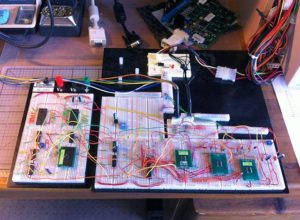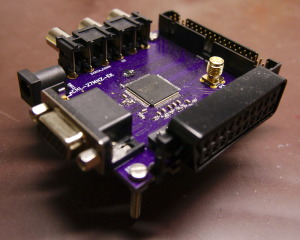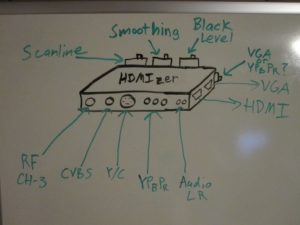News, Retrogaming news
Four upcoming upscaling solutions
The video processor market is going through some changes at the moment. At the high end, manufactures like Lumagen and Pixel Magic are looking towards 2k and 4k upscalers. Meanwhile for videogamers, the XRGB Mini is still the scaler of choice. Interesting things are happening with televisions too, particularly where scaling is concerned. A few years ago, most televisions had mediocre deinterlacing and scaling at best, but in recent years this has improved significantly. It’s interesting that venerable video processors like the DVDO Edge or the iScan VP50, which once had scaling that was considered rather good, now fail to meet up to the standards of the scalers built into televisions such as the latest Sony sets.
The earliest video game upscalers were simple line-doubling devices. The original XRGB and the XRGB2 were released in the 1990s and simply took the 15khz 240p signal and line doubled it to 480p/31khz, allowing older systems to be run on things like computer monitors. One benefit of this approach was speed, the early XRGB devices added no input lag whatsoever to the line doubled image. Given that TVs now upscale 480p images rather well, an ideal, affordable device for many gamers would be a return to the simple line-doublers of the past, but this time with HDMI or component video outputs. We’re not the first to reach this conclusion and there are a number of exciting new game-centric video processing devices in development that work around this ethos.
GBS 8200/8220 CFW Project
 Everyone who has ever owned a video processor has at some time wished that they were smart enough to write their own firmware for the device. Ingenious user Dooklink from the Shmups forums has managed to do just that on the old GBS 8200/8220 device. For those of you who haven’t heard of this particular scaler, it’s a budget device designed originally for arcade operators looking for a cheap way to display older games on newer monitors. The board is also sold in a package by Arcadeforge.de as the “SLG in a Box”. While results with this scaler were acceptable, they weren’t actually that much better than the scaling and processing a typical TV could do. Just like with a HDTVs built in processor, 240p signals are processed as 480i.
Everyone who has ever owned a video processor has at some time wished that they were smart enough to write their own firmware for the device. Ingenious user Dooklink from the Shmups forums has managed to do just that on the old GBS 8200/8220 device. For those of you who haven’t heard of this particular scaler, it’s a budget device designed originally for arcade operators looking for a cheap way to display older games on newer monitors. The board is also sold in a package by Arcadeforge.de as the “SLG in a Box”. While results with this scaler were acceptable, they weren’t actually that much better than the scaling and processing a typical TV could do. Just like with a HDTVs built in processor, 240p signals are processed as 480i.
Dooklink’s new firmware goes some way to fixing some of these problems. With his custom code, there’s now a pure line-doubling mode, that doesn’t suffer from deinterlacing artefacts. Various errors with PAL (50hz) consoles have also been corrected. Sadly the linedoubling mode still causes some degree of input lag, but at least the images are displayed correctly now. Currently the project requires a Rasberry Pi mini-computer to be used as a bridge for the new firmware, but Dooklink hopes to find a way to flash the firmware on existing devices in the future. You can check out the project by visiting this thread on the Shmups forum.
Bitblitz
 Bitblitz is the brainchild of Crafty Mech, who brought us the Mini SLG. The board aims to be a simple line-doubling device, analogue 240p goes in and 480p comes out via a D-Sub15 (VGA connector). The board will support both 240p and 288p and line-double both, though users wishing to run PAL systems may have to convert the output to component or HDMI, since few displays support 576p 50hz VGA input. The device has virtually no lag (Crafy claims 63 MICROseconds) and includes a scanline generator too. Support for 480i and games that switch between 240p and 480i has not yet been finalised.
Bitblitz is the brainchild of Crafty Mech, who brought us the Mini SLG. The board aims to be a simple line-doubling device, analogue 240p goes in and 480p comes out via a D-Sub15 (VGA connector). The board will support both 240p and 288p and line-double both, though users wishing to run PAL systems may have to convert the output to component or HDMI, since few displays support 576p 50hz VGA input. The device has virtually no lag (Crafy claims 63 MICROseconds) and includes a scanline generator too. Support for 480i and games that switch between 240p and 480i has not yet been finalised.
Crafty claims the project is around 75% complete, but admits it keeps getting stalled due to other commitments, such as his upcoming test pattern generator. You can read more about the BitBlitz project by visiting this thread on the the Shmups forum.
DIY video digitizer & scandoubler
 While this project may still be without a proper name, that doesn’t make it any less exciting. Again, this project was announced on the Shmups forum, this time by the user Marqs from Finland. The picture on the left shows one of the exciting shots of the prototype. For a homebrew project the device has an impressive range of features, including almost no input lag, support for 240p and 480i and possibly most exciting of all, enhanced support for games which switch between 240p and 480i. Input is via SCART, D-Sub 15 (VGA Style) or Component video, while output is via HDMI. Scanlines can be added to the upscaled image too.
While this project may still be without a proper name, that doesn’t make it any less exciting. Again, this project was announced on the Shmups forum, this time by the user Marqs from Finland. The picture on the left shows one of the exciting shots of the prototype. For a homebrew project the device has an impressive range of features, including almost no input lag, support for 240p and 480i and possibly most exciting of all, enhanced support for games which switch between 240p and 480i. Input is via SCART, D-Sub 15 (VGA Style) or Component video, while output is via HDMI. Scanlines can be added to the upscaled image too.
Marqs even went as far as to produce a demonstration video showing how the unit coped with a game that switched between progressive and interlace modes on the fly, you can watch the video here. As you can see, there’s really no delay between switching modes at all, a far cry from the several seconds the XRGB Mini makes us wait! You can find out more about the project by visiting this thread on the Shmups forum.
HDMIzer
 HDMIzer is a proposed product from HD Retrovision, the start up company we discussed in our recent article, Clearing up the HD Retrovision confusion. The device accepts 15khz video in a wide range of formats, including RF, composite, S-Video or component format (though curiously not RGB) and outputs a 480p or 576p via HDMI. Optional scanlines can be added to the processed image too, and output is to either VGA, component or HDMI. HD Retrovision are aiming to keep the device basically input lag free, with less than one line (200 microseconds) of lag. We asked HD Retrovision how far along the project was and we can confirm it only exists as a block diagram at present, so it could be some time yet before the device is brought to market. You can find out more information about this project by visiting this page.
HDMIzer is a proposed product from HD Retrovision, the start up company we discussed in our recent article, Clearing up the HD Retrovision confusion. The device accepts 15khz video in a wide range of formats, including RF, composite, S-Video or component format (though curiously not RGB) and outputs a 480p or 576p via HDMI. Optional scanlines can be added to the processed image too, and output is to either VGA, component or HDMI. HD Retrovision are aiming to keep the device basically input lag free, with less than one line (200 microseconds) of lag. We asked HD Retrovision how far along the project was and we can confirm it only exists as a block diagram at present, so it could be some time yet before the device is brought to market. You can find out more information about this project by visiting this page.

